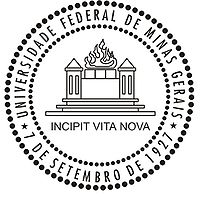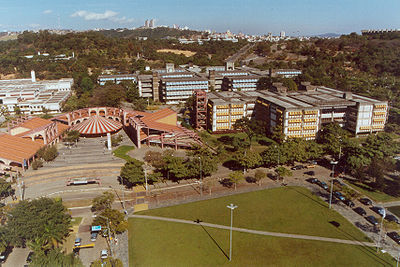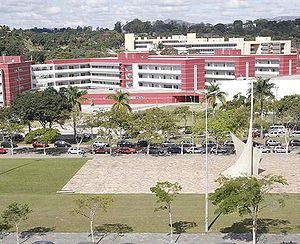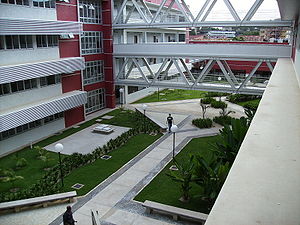|
(Redirected from Federal University of Minas Gerais)
| Universidade Federal de Minas Gerais |
 |
| 校训 |
Incipit Vita Nova (拉丁语) |
| 英语校训 |
A new life begins |
| 建立于 |
1927 |
| 类型 |
Public University |
| 捐赠 |
R$ 1.078.315.210,14 (2008) |
| Rector |
Clélio Campolina Diniz |
| 工作人员 |
4,445 |
| 本科生 |
22,202 |
| 研究生 |
10,490 |
| 位置 |
Belo Horizonte, Minas Gerais, Brazil |
| 校园 |
Urban, 8,794,767 square meters |
| 网址 |
www.ufmg.br |
Universidade Federal de Minas Gerais (Federal University of Minas Gerais, abbreviated as UFMG) is a public university located in Belo Horizonte, state of Minas Gerais, Brazil. The students are admitted through yearly exams called vestibular.
UFMG is one of Brazil's five largest universities. It offers 75 different undergraduate degrees, including an extremely sought-after Medicine degree, more traditional options such as Law and Economics, plus a handful of Engineering and a wide array of Science and Art degrees. It also offers 57 PhD programs, 66 MSc programs, 79 Post-Baccalaureate programs and 38 medical internship programs. In total, UFMG has a population of 37,479 students.
Its undergraduate courses were ranked in 1st place in the 2007 results for the National Student's Performance Exam (ENADE) and 4th place in the 2008 results. In particular, courses in the exact sciences area are of very high quality and its Computer Science course was considered the best in the country by the latest edition of ENADE.
The current rector of UFMG is Prof. Clélio Campolina Diniz. Famous past students include former Brazilian president Juscelino Kubitschek; writer, medical doctor and diplomat João Guimarães Rosa, plastic surgeon Ivo Pitanguy, poet Carlos Drummond de Andrade and pop singers Samuel Rosa and Fernanda Takai.
Location
UFMG is located in the northern part of Belo Horizonte, in the neighborhood of Pampulha. The campus area totals 8,775,579 square meters, while built area reaches 620,735 square meters. This is divided in three main campi (Pampulha Campus, Health Sciences Campus in Central Belo Horizonte and Rural Sciences Institute in Montes Claros together with a few buildings spread in other parts of Belo Horizonte, such as the School of Architecture. Inside the Pampulha Campus there is the CDTN, a Federal Institute for Nuclear Sciences Research; it includes 38 buildings, 50 laboratories and one 250 kW Nuclear Reactor built in 1960 named TRIGA. There is also an extensive area of secondary forest known as the Estação Ecológica ("Ecological Station"), where some university scientists - mainly ecologists and zoologists - carry out research; this is the largest "green" area within the city boundaries, and is home to several endemic insect species. In the academic years of 2007 and 2009, the Ministry of Education has ranked the UFMG as the best University in Brazil, after a detailed examination over all institutions of higher education.
History of UFMG

Campus Pampulha - UFMG Foto: Eber Faioli
In 1898, the Ouro Preto Faculty of Law was transferred to Belo Horizonte, which at the time was set to be the new state capital.
A few new unconnected faculties would be founded later: in 1907, the Free School of Dentistry; in 1911, the Faculty of Medicine, the School of Engineering, and a course in pharmacy attached to the Free School of Dentistry.
In 1927, these four schools merged to found UMG, University of Minas Gerais, a private institution subsidized by the state government.
The UMG remained funded by Minas Gerais government until 1949, when funding had been delegated to Brazilian Government. Even though, the name UFMG was not adopted until 1965.
At the time of federalization, the schools of architecture, philosophy and economics were already integrated in the university. As its expansion carried on, the School of Nursing (1950), Veterinary Science (1961), Information Science (1962), Music (1962) and Physical Education (1969) were founded.
In 1968, a university reform altered profoundly the structure of UFMG. The College of Philosophy spawned multiple institutions: the College of Philosophy and Human Sciences, the Institute of Biological Sciences, the Institute of Exact Sciences, the Institute of Geosciences and the Colleges of Literature and Education.
Five additional courses have been established recently: agronomy, theater, control and automation engineering, computational mathematics, and speech therapy/audiology.
UFMG in numbers

School of Economics (foreground) and School of Engineering (background)

School of Economics' interior
Undergraduate Entrance Examination (2010)
- Candidates:62,011
- Openings:6,600
- Candidates/openings Ratio:9.04
Teaching Programs
- Undergraduate: 75
- Doctorate: 57
- Master's: 66
- Post-Baccalaureate: 79
- Medical Internship: 38
- Distance Courses:9
University population
- Undergraduate: 24,552
- Post-Baccalaureate: 5,918
- Master's: 3,814
- Doctorate: 2,880
- Medical Internship: 315
- Primary/Secondary and High School: 1,591
- Total UFMG students: 37,479 (2009)
Research
- Research groups : 732
- Research topics : 2,540
- Scientific publications : 11,814 (2007)
- National patents : 270
- International patents : 97
- Contracts of Technologic Transfer: 30
- Registered Trademarks and software: 68
- Royalties Revenue (2004-2009): R$ 1,064,686.01
Degree held by Professors
- Bachelor: 69 (3%)
- Post-Baccalaureate: 85 (3,6%)
- Master's: 318 (13,4%)
- Doctorate: 1,904 (80%)
International Affairs
- Partner institutions: 156
- International agreements: 218
- Foreign students: 430
- Visiting students: 185
- UFMG students abroad: 206
- International mobility programs: 71
Territory
- Total area: 8,775,579 m
- Built area: 620,735 m
- Campi: 3
- Academic units: 20
- Special units: 3
Publications (yearly)
- UFMG University Press
- New titles: 32
- Issues of Vestibular 2004: 16
- Revised and expanded editions: 5
- Catalogs: 1
- Reprints: 10
- UFMG Diversa Magazine: 150.000 year
- UFMG Newsletter: 368,000 copies
UFMG's annual budget
- R$ 1,078,315,210.14
Blocks
- Colégio Técnico - Coltec
- Centro Esportivo Universitário - CEU
- Escola de Arquitetura
- Escola de Belas-Artes - EBA
- Escola de Ciência da Informação (Escola de Biblioteconomia)
- Escola de Educação Física, Fisioterapia e Terapia Ocupacional - EEFFTO
- Escola de Enfermagem
- Escola de Engenharia
- Escola de Música
- Escola de Veterinária
- Faculdade de Ciências Econômicas - FACE
- Faculdade de Direito
- Faculdade de Educação - FAE
- Faculdade de Farmácia
- Faculdade de Filosofia e Ciências Humanas - FAFICH
- Faculdade de Letras - FALE
- Faculdade de Medicina
- Faculdade de Odontologia
- Instituto de Ciências Biológicas - ICB
- Instituto de Ciências Exatas - ICEx
- Instituto de Geociências - IGC
- Parque Tecnológico - BHTEC
参考文献
- ^ Template:Citar web
- ^ Complete list of the best Brazilian universities (in Portuguese) [1]
- ^ ENADE is an exam created by the Brazilian federal government to objectively rank universities.
- ^ (in portuguese)[2]
- ^ Best and worse exact sciences courses in Enade (in portuguese)[3]
External links
更多
- Brazil University Rankings
- Universities and Higher Education in Brazil
|
|



